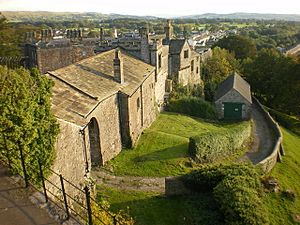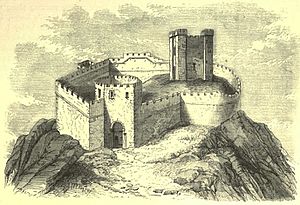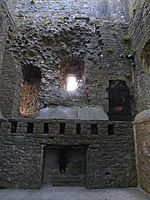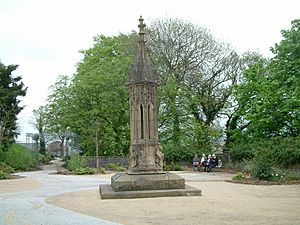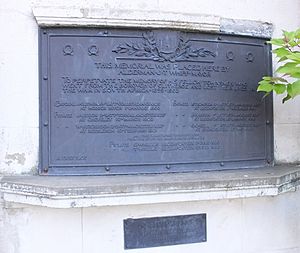Clitheroe Castle facts for kids
Quick facts for kids Clitheroe Castle |
|
|---|---|
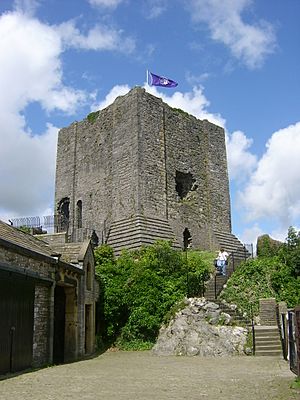
The keep at Clitheroe Castle, August 2007
|
|
| Location | Clitheroe, Lancashire, England |
| OS grid reference | SD 742416 |
| Built | 12th century |
| Built for | de Lacy family |
| Designated | 10 April 1915 |
| Reference no. | 1016196 |
|
Listed Building – Grade I
|
|
| Designated | 19 May 1950 |
| Reference no. | 1071553 |
| Lua error in Module:Location_map at line 420: attempt to index field 'wikibase' (a nil value). | |
Clitheroe Castle is an old castle in Clitheroe, Lancashire, England. It's mostly in ruins now, but it was once the main centre of a huge area of land called the Honour of Clitheroe. This land stretched along the western side of the Pennines mountains.
Historians believe the castle was built by the Normans in the 12th century. It belonged to the powerful de Lacy family for many years. Later, it became part of the lands owned by the Duchy of Lancaster. In 1660, it was given to George Monck, 1st Duke of Albemarle. The castle stayed in private hands until 1920. Then, it was sold to the people of Clitheroe to become a special memorial for soldiers who died in World War I.
Today, the buildings at the castle site are home to the Clitheroe Castle Museum. The castle's main tower, called the keep, is the second smallest stone-built keep still standing in England. Clitheroe Castle is a very important historical site. It was made a Scheduled Monument in 1915 and a Grade I Listed Building in 1950.
Contents
Clitheroe Castle: A Look Back in Time
How the Castle Began
After the Normans took over England, the area around Clitheroe was given to a Norman lord named Roger de Poitou. He then gave it to others. Clitheroe itself wasn't mentioned in the old Domesday Book survey. People think that Blackburn was the main town back then.
Later, Roger de Poitou gave this area, including the Lordship of Bowland, to Robert de Lacy. Even when de Poitou lost his lands in 1102, King Henry I let de Lacy keep these lands and even added more. This is how Clitheroe became the centre of this new important area, known as the Honour of Clitheroe.
The River Ribble valley has always been a key travel route. An old Roman road runs right through it, just south of the castle. The castle sits on a steep limestone hill, about 39 metres (128 feet) high. This spot was perfect for watching over the area and controlling the pass.
Who Built Clitheroe Castle?
An old document from the 1300s says that Robert de Lacy (died 1193) built the castle. He was the grandson of the first Robert de Lacy. Most people agree that he built the stone keep, but it's likely there was some kind of fort there before.
Some believe a wooden fort might have been on the hill even before the Normans arrived. There's a mention of a "castellatu Rogerii pictaviensis" in the Domesday Book. This could mean Roger the Poitevin built the first fort before 1086. However, others think this refers to Lancaster Castle.
We know there was a castle at Clitheroe by 1102. A document from 1122 also mentions the castle's chapel. In 1138, a Scottish army fought an English force at the Battle of Clitheroe. The castle isn't directly mentioned, but it might have been why the battle happened there.
From the 12th to 14th Century
New building work happened in the late 1100s by Robert de Lacy (who died in 1193). He had no children, so his lands went to his cousin, and then to her grandson, Roger de Lacy (1170–1211). Roger changed his last name to de Lacy. His family later became the Earls of Lincoln.
The castle had soldiers stationed there in the 1190s because King Richard I's brother John rebelled. In the early 1300s, repairs were made to the castle buildings, and a new gate was built.
When Henry de Lacy, 3rd Earl of Lincoln died in 1311, his properties went to Thomas, 2nd Earl of Lancaster. Thomas was married to Henry's daughter, Alice. In 1315, a rebellion led by Sir Adam Banastre raided Clitheroe Castle for weapons. After Thomas was executed in 1322, his lands were taken by the King. Later, his brother Henry got the lands back. These lands then became part of the Duchy of Lancaster.
From the 15th to 17th Century
In the 1400s, more repairs were done, and a new room was built in 1425. During the Wars of the Roses, King Edward IV ordered £200 to be spent on castle repairs. But after this, the castle seems to have fallen apart. Records from the 1480s show the castle still had a constable (like a manager) and a porter (gatekeeper).
By 1602, a survey said the castle was "very ruinous," meaning it was falling apart. Another survey in 1608 said parts of the buildings had already collapsed.
During the English Civil War in 1644, Prince Rupert left soldiers at the castle. They fixed the main gate and brought in supplies. But they left after the Royalists lost the Battle of Marston Moor. In 1649, the local army refused to leave and took over the castle for a short time because they hadn't been paid. That same year, Parliament decided to 'slight' (partially destroy) many castles, including Clitheroe, to stop them from being used in future wars. It's not clear how much damage was actually done to Clitheroe Castle.
In 1660, the castle was given to the Duke of Albemarle by King Charles II. This was a reward for helping the King get his throne back. From the late 1600s, the castle became the home of the steward, who managed the Honour of Clitheroe.
From the 18th Century to Today
The castle's ownership passed down through the Duke of Albemarle's family to the Dukes of Buccleuch. A map from 1723 was likely made when a new house was built for the steward. Around this time, much of the remaining outer wall was taken down, and garden terraces were created. The castle continued to be the main office for the area until 1822.
In 1848, the ruined keep was in danger of falling down. So, repairs were made, costing at least £221. This work included rebuilding the staircase tower and adding supports to the walls.
In November 1920, the people of Clitheroe bought the castle site for £9,500. They wanted to create a memorial for the 260 soldiers from the town who died in World War I.
More preservation work was done on the keep in the late 1980s. In 2008, as part of a big museum update, more restoration work happened. The first archaeological survey of the site was also completed, with some test digs.
What Clitheroe Castle Looks Like
Clitheroe Castle is known as an enclosure castle. This means its main defence was the wall surrounding the site. It was built like a motte-and-bailey castle, using a natural hill as the "motte" (mound).
The keep (main tower) is the second smallest stone-built keep still standing in England. Because the keep was so small, other important buildings like the great hall were probably located elsewhere on the site. An old survey from 1602 mentions a hall and a buttery (a room for food and drink). There would also have been stables and places for soldiers to sleep.
Today, the medieval castle keep and some parts of the outer wall (called the curtain wall) are still visible. However, the other medieval buildings are gone, though their foundations might still be underground. Old documents mention ditches and moats, but these have been filled in. The path leading up to the keep and the western road are thought to be newer additions.
The Keep: Castle Tower
The keep is a square tower with flat pilasters (like flattened columns) at its corners. The walls are about 2.7 metres (8.75 feet) thick at the bottom. The ground floor probably had a trapdoor entrance from above. It had narrow arrowslits (openings for archers) on three sides. Two of these have been changed into entrances, and one is filled in.
The main entrance to the keep was on the first floor, on the northwest side. You would have reached it by an outside staircase. Next to this, a spiral staircase goes up inside a corner tower. Today, it reaches about 14 metres (46 feet) high, taller than the other walls. The keep likely had a parapet (a low wall) and at least one small tower above the staircase.
The first floor also had another door in the southwest wall. This door might have led to the ramparts of the nearby curtain wall. What looks like another doorway next to it was actually a small, arched room inside the wall. This room might have been a garderobe (a medieval toilet), but this is debated.
The walls above the first floor don't show signs of other openings, even to the staircase. This might mean the rebuilding work removed them, or the walls hid a sloped roof, like at Peveril Castle. There's also no sign of fireplaces in the keep. The repairs done in the 1800s used limestone from nearby Chatburn, so you can see which parts are newer.
The Hole in the Wall
The arrow loop on the southeast side of the first floor is now a wide hole. This is probably from natural decay. There's an old local story that the Devil once threw a huge rock at the castle from Pendle Hill. But his apron broke, dropping the stones and making the rock land near Pendleton church instead.
The castle guidebook also shares a local tale: "they always said that the hole in the side of the keep was made by Oliver Cromwell in the English Civil War. It's only a story but they say that he attacked the castle and fired at it with a cannon from the top of Pendle Hill – it must have been a good cannon for the time to reach that far!"
Gatehouse and Outer Walls
The castle's gatehouse tower probably stood where the stone gate pillars are now, on the drive up to the museum. A tall, embattled (with battlements) wall is thought to have run around the top of the hill.
An old drawing from the 1500s shows a four-sided, two-story gatehouse with a round-arched Norman doorway. The door had a small wicket gate (a smaller door within a larger one). The upper floor might have been where the castle porter, who also acted as the jailer, lived.
To the west, parts of the curtain wall still climb the slope. It has been suggested that the 1.8-metre (6-foot) wide wall around the keep on three sides might be older than the keep itself. It might have been a shell keep (a wall enclosing a courtyard) with lean-to buildings inside. Like the keep, this part of the wall was rebuilt in the mid-1800s.
The castle grounds were likely divided into an inner and outer section. There might have been a second gatehouse or ditch to control entry, but no trace of these remains. The garden terraces built in the mid-1700s changed much of the site, making it hard to see the original castle layout.
Chapel and Great Hall
A chapel dedicated to St. Michael was inside the castle, mentioned in documents from 1120. It was separate from the main church of Whalley. It had strong walls and was part of the inner castle wall. It was located at the southern end of a terrace.
The inner castle area probably also had the great hall. A document from 1324 talks about rebuilding a large structure, which would have been the great hall. It took five carpenters over 17 weeks to build, using lots of timber and stone for the roof.
This hall was where the local court was held, with the castle steward acting as judge. Important people were sometimes imprisoned at the castle. It's not certain if the keep was used as the jail, or if there was a separate dungeon elsewhere.
Clitheroe Castle Museum
Today, the buildings on the castle site are home to the Clitheroe Castle Museum. The museum is located in the old Steward's House, which is a Grade II listed building. It was built in the 1700s and has been changed over time. The old courthouse is now a space for temporary exhibitions.
The museum first opened in 1954. It had a big £3.5-million renovation and officially reopened on June 23, 2009. The museum has about 5,000 items related to local history. It also has collections of geology (rocks and fossils), natural history, local art, and old costumes. The archaeology collection includes items found during digs at the castle site.
Castle Grounds and Park
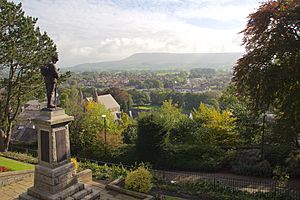
The 6.4-hectare (16-acre) castle site was turned into a public park after the council bought it in 1920. Out of the £15,000 raised, £9,500 was used to buy the site, and the rest was spent on creating the park. The park includes the old garden terraces from the steward's house.
The park has bowling greens, tennis courts, a putting green, a bandstand, and a café. Special trees were planted, like a fern-leaf beech and a dawn redwood. The war memorial is south of the keep. It's a sculpture of a soldier on a pedestal. The main words say it was built by the people of Clitheroe to remember those who died in the Great War (1914-1918). There's also a plaque for those killed in the Second Boer War, added in 1907.
The centrepiece of the old rose garden is a turret from the Houses of Parliament in London. It was given to Clitheroe in 1937 to celebrate the coronation of King George VI. This turret, also called the Pinnacle, dates back to the mid-1800s. A project is underway to fix it because rusting iron parts were damaging the stone.
In April 2006, a new skatepark opened in the castle grounds. Its £200,000 cost was paid for by a charity. Also opened in 2006 was a turf labyrinth. In 2010, ten plaques about Clitheroe's history were put up near the keep. To mark 400 years since the Pendle witches trials, a new walking route called the Lancashire Witches Walk was created. One of the special markers for this walk is located here.
The town's annual Guy Fawkes Night bonfire and fireworks display is one of many regular events held at the castle.
Castle Hill: A Geological Wonder
The keep sits on top of a large carboniferous rock, which is the highest point for miles around. This rock is a special type of limestone called a Waulsortian mudmound. It's light grey, with many cracks filled with calcite. It also has some galena and sphalerite minerals. You can find lots of fossils here, mainly parts of crinoids (sea lilies), along with snails and brachiopods (shelled sea creatures).
Scientists have debated how these mud mounds formed. One idea was that they were "reef knolls." Clitheroe Castle is the most southwesterly of a chain of these mud mounds in the area, known as the Clitheroe 'Reef' Belt. These include important geological sites at places like Salthill and Bellman quarries.
|




